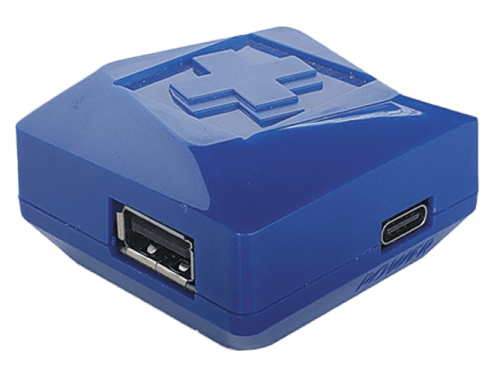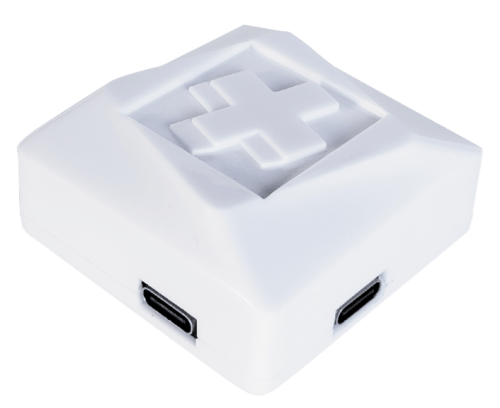How to Add External Storage to Your Tablet
4 Min Read
June 22, 2023
Tablets come with a fair bit of storage these days. Still, you may want to add an external drive for extra storage or transfer files that are too big to email. To do this, you will need an adapter or hub as you can’t connect a hard drive or USB thumb drive directly to a mobile device. Here’s how you can add the drive using LAVA’s Charge Plus adapter.
Charge-Plus adapter
 The Charge-Plus is one of LAVA’s consumer SimulCharge adapters, which provides simultaneous charging and data to select USB-C mobile devices. It features one USB-A port for a peripheral, such as a hard drive or USB memory stick.
The Charge-Plus is one of LAVA’s consumer SimulCharge adapters, which provides simultaneous charging and data to select USB-C mobile devices. It features one USB-A port for a peripheral, such as a hard drive or USB memory stick.
Attaching an external hard drive or USB memory stick
Attaching external storage to the tablet using the Charge-Plus is a simple process.
Step One: Attach the external hard drive or USB memory stick into the Charge-Plus adapter’s USB-A port.
Step Two: Apply power to the Charge-Plus adapter. Plug the tablet’s power supply into the adapter’s USB-C power port and an AC power source, such as an electrical outlet. If you are attaching an external hard drive, you will likely hear it boot up at this point.
Step Three: Connect the adapter to the tablet using a USB-C to USB-C cable. On the tablet, the cable plugs into the power port. On the adapter, it plugs into the USB-C port labelled, “Device.”
After this, you’re done. Assuming Android can read the drive, you should be able to access it through the operating system’s file manager. (If Android cannot read the drive, see here for more information.)
Using the Charge-Plus in OTG mode
The Charge-Plus can also be used in OTG mode, where the tablet operates in what is called USB Host Mode and can both power and access peripherals.
If you want to use the tablet in OTG mode, you can skip step two and power everything from the tablet’s battery. It is also a useful option if the tablet isn’t USB-C PD compatible. For an adapter to provide power and data at the same time, the USB-C PD specification must be implemented on the device. In other words, if the tablet doesn’t have USB-C PD, it can’t work in SimulCharge mode. However, most USB-C devices are OTG compatible so they will still work with the adapter in OTG mode even if they can’t do SimulCharge.
OTG should work fine with the memory stick as it requires very little power to operate. Many external hard drives require more power than can be delivered over OTG and so you will be only to effectively use it if it is receiving power through the adapter.
Upgrading to the uSynC-1U MINI
 If you know you will only be using the external storage in a static setup, you can also upgrade to the uSynC-1U MINI.
If you know you will only be using the external storage in a static setup, you can also upgrade to the uSynC-1U MINI.
This enterprise SimulCharge adapter is the same form factor as the Charge-Plus but also includes 24/7 plug-and-play battery protection with Continuous Active Battery Modulation (CABM). CABM detects when the mobile device is near a full charge and then turns off charging for a preset number of hours. This prevents the device from overcharging and extends its overall battery life.
What to do if the drive is unreadable
If Android can’t read the external storage device when it is attached to the tablet, this likely has to do with its formatting. Android can only read storage devices formatted with either FAT32 or exFAT journaling file systems.
Most USB memory sticks use FAT32 so you will likely won’t encounter this issue when using one. However, external hard drives are often used with PCs and so are often formatted with the more-advanced NTFS, which Android can’t read.
If Android can’t read your drive, you have two options:
One, you can hook up the drive to a PC and reformat it. With Windows, you can reformat the drive as either FAT32 or exFAT – though exFAT is recommended, especially if you’re dealing with large files. (FAT32 can’t handle files greater than 4GB.) Of course, if you already have files on the drive, you will need to back them up before reformatting.
Two, you can install a third-party Android app that will let you read the drive. For more information on how to do this, watch this video.
Unmounting the drive
When you are finished using the hard drive or USB memory stick, you should unmount it first. Go into the tablet’s settings and tap on “Battery and device care.” On the next screen, choose “Storage.”
Tap on the three dots on the top-right of the following screen and choose “Advanced.” You will then be able to see the attached USB hard drive listed in the menu. Tap on the listing and unmount the drive.
Once you have done that, you can safely remove the USB external drive or memory stick.
The ideal device for adding storage to your tablet
The Charge-Plus is the perfect adapter to add extra storage to your tablet or smartphone. Providing simultaneous power and data to the mobile device, the adapter can easily connect to an external hard drive or USB memory stick. Depending on the amount of power the peripheral needs, the adapter can also operate in OTG mode so you don’t need to be near an electrical outlet.
For static setups, the uSynC-1U MINI offers much of the same functionality as the Charge-Plus but includes 24/7 plug-and-play overcharge to extend the life of your device’s battery.
Contact sales at sales@lavalink.com or 416-674-5942 for more information about the Charge-Plus and uSynC-1U MINI.
Subscribe to LAVA’s Newsletter and stay up to date on the latest company news, new product releases, and tech industry insights.
